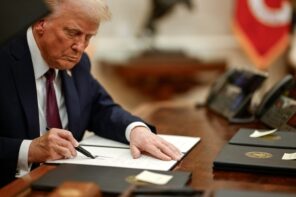In 1970 Mark Hatfield delivered the commencement address at Fuller Theological Seminary, the nation’s premier neo-evangelical seminary. The senator, “a verbal spellbinder,” dark and “too handsome, almost, for his own good,” according to political observers, cut quite a figure. Having just made news for co-sponsoring the Hatfield-McGovern “amendment to end the war,” he was greeted enthusiastically. One-third of the graduating class, which cheered as the senator walked into the room, wore black bands to signify opposition to the war. Students in a balcony unfurled a banner that read, “Blessed are the peacemakers. We’re with you, Mark.” Hatfield’s speech, entitled “American Democracy and American Evangelicalism—New Perspectives,” returned the favor.
Fuller’s mandate, Hatfield said, was to offer a social and ethical alternative to the “Biblical Nationalists.” Fuller’s evangelical leadership should revolve around three pressing issues—war, race, and the distribution of wealth—all moral, even spiritual, obligations that could return evangelicalism to the “entirety of the gospel.”
This episode in evangelical history marked a moment of opportunity for progressive evangelicals. Hatfield did not embody the evangelical left perfectly; he was, after all, an anti-New Deal fiscal conservative in the Republican Party. But he pursued its unorthodox agenda in most respects. He was an unambiguous social conservative on abortion, but against capital punishment. He was an anti-war environmentalist. His populist call for “genuine political, economic, and ecological self-determination” meant reducing “excessive concentration of power” everywhere—not only in the executive branch of government and labor unions, but also in big corporations and the military.
Despite this idiosyncratic platform, Hatfield thrived. Large numbers of Hatfield admirers at Fuller Seminary, Wheaton College, and the campus ministry InterVarsity Christian Fellowship formed the architecture of an emerging evangelical left in the early 1970s. One InterVarsity leader at Kansas State University, citing his civil rights, anti-poverty, anti-war, and environmental record, said that Hatfield “put into words what we were thinking.”
The Post-Americans (later renamed Sojourners), an evangelical commune that launched a New Left tabloid, claimed him as their mentor. Soon after meeting, Hatfield led the long-haired Jim Wallis and his ragtag group of Post-Americans into the Senate Dining Room as the power elite gaped between bites of grilled Atlantic salmon. The glint in Hatfield’s eyes betrayed his glee at the subversive act.
Hatfield’s Oregon constituents also approved of his fierce independence. Evangelical pietists from rural districts liked stories of their governor suddenly stopping his state vehicle to pray. Campus radicals in Portland called him the “grooviest senator in the nation.” “One Sunday he will give us as liberal a speech as you will want and the next Sunday will come out with fundamentalist talk,” said one political observer. Hatfield got away with it. In a remarkable forty-five year run in political office, he lost only one election—for student body president in college. Astonishingly, Hatfield, tolerated and admired by the left and right, was considered by both the Democratic George McGovern and the Republican Richard Nixon as a vice-presidential nominee.
It is difficult to imagine such bipartisanship now. By the 1980s, both Republican and Democratic leaders had begun to enforce party orthodoxies. A Democratic Party turning toward cultural liberalism had little patience for his pro-life stance. And some evangelicals tired of his anti-war activism. A politicizing Bill Bright of Campus Crusade discontinued his advisory board, which Hatfield served on, partly because of complaints about “so-called Christians like Mark Hatfield.”
Despite the animosity, Hatfield continued to cross the aisle. With Massachusetts senator Ted Kennedy, he sponsored nuclear freeze legislation, opposed Reagan’s invasion of Grenada, and was one of only two Republicans to vote against the 1990 invasion of Iraq. Confounding political allies and opponents alike, he also remained an outspoken opponent of abortion and the death penalty. For these and other positions, Hatfield came under relentless attack by the Republican leadership. After he cast the decisive (and lone Republican) vote against a balanced budget amendment in 1995, party leaders tried to remove him as chair of the Senate Appropriations Committee. Groovy no longer and weary of bucking his party, Hatfield retired a year later.
Hatfield’s departure symbolized the weakened state of the broader evangelical left amidst hardened political structures. Politically homeless, progressive evangelicals had been left behind by the religious right and a secularizing Democratic Party. Twenty years later, Hatfield’s death comes amidst a similarly poisoned political culture. Bitter showdowns over abortion, health care, and budgets suggest that conditions seem not to have changed. Perhaps renewed attention to the more flexible and civil politics of an earlier era can offer a way out of today’s angry brinksmanship.











